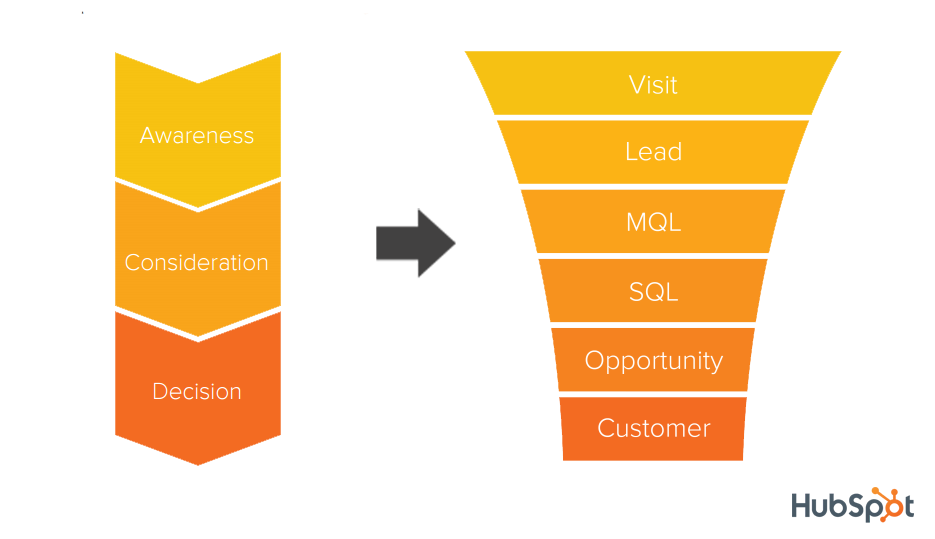What are Lifecycle Stages?
The customer lifecycle outlines the steps taken by a customer as they progress through the marketing and sales funnel. The steps can be aligned with stages such as subscriber, marketing qualified lead, sales qualified lead, and customer.
Why are Lifecycle Stages important?
Updating the Lifecycle Stage property consistently allows your team to determine where a specific contact is in your processes, and understand better how leads are handed off between marketing and sales. Companies where marketing and sales are aligned, including knowing which contacts to handoff and when, earn more revenue:
- Misalignment between sales and marketing technologies and processes costs B2B companies 10% of revenue or more per year.
- Companies with good "smarketing" (sales and marketing aligned) practices in place generated 208% more revenue from marketing efforts.
- When sales and marketing teams work together, companies see 36% higher customer retention and 38% higher sales win rates.
By consistently marking and updating the Lifecycle Stages of your contacts, you'll collect insights on your strategy such as how long it takes to close a customer or what stage/processes are resulting in a bottleneck for your business.
How to Make Your Sales Forecasts More Accurate
Remotish Recommended Lifecycle Stages in HubSpot
-
Subscriber – Blog subscribers (opted in themselves)
-
Lead – Used as a catch-all for leads that are lost and where they came from needs to be identified and updated to automatically apply their appropriate Lifecycle Stage at the time of entry into the database. (Someone will need to own the monitoring so that this stage stays empty).
-
Marketing Qualified Lead (MQL) – Anyone that has requested marketing information (filled out a form to download content, Top-of-the-funnel (ToFu) or middle-of-the-funnel (MoFu) content like a PDF guide). MQLs may also include downgraded SQLs who had no response and no sales activities within the last (depends on your sales process) XX days. Sales does not contact MQLs.
-
How the MQL stage is changed:
-
Forms have a hidden field to denote the Lifecycle Stage of someone filling out that form
-
Workflows may also control lead progression when a standard form download is not involved (like a SaaS free trial where the user makes an account directly in the application)
-
Workflow to downgrade leads from SQLs
-
-
Sales Qualified Lead (SQL) – People that fill out contact us forms, demo forms, or are scheduled for a demo meeting. SQLs also come from uploaded lists or manually input leads. SQLs should be suppressed from receiving marketing communications.
-
How SQLs stage is changed:
-
Forms have a hidden field to denote the Lifecycle Stage of someone filling out that form
-
Workflows may also control lead progression when a standard form download is not involved (like a SaaS free trial where the user makes an account directly in the application)
-
Uploaded lists and manual contact input need to be marked manually at upload
-
-
-
Opportunity – People whose company is in a deal
-
How this stage is changed:
-
HubSpot updates this Lifecycle Stage automatically once a company is in a deal
-
-
-
Customer – People whose company has given us $
-
How this stage is changed:
-
When deal changed to closed-won HubSpot changes this automatically
-
-
-
Evangelists – This could be referral partners or other aligned organizations
-
How this stage is changed:
-
This stage is manually updated
-
-
-
Other – vendors, employees, or job applicant
-
How this stage is changed:
-
This stage is manually updated
-
-
Lifecycle Stage Examples
Example 1
-
Someone visits the website and subscribes to the newsletter or blog updates
-
The form they fill out to subscribe will automatically show them as the "Subscriber" Lifecycle Stage. They receive our blog digest for a while and a piece of content advertised catches their eye, such as a Top-of-the-funnel (ToFu) guide (PDF).
-
They fill out a form to download the guide. The form they fill out to download will automatically show them as the "MQL" Lifecycle Stage. Filling out the form also enrolls them in a workflow where they receive offers for another piece of content, which if they download that too, they will receive emails asking if they’d like to book a demo.
-
Once they fill out the form to book a demo, the form they fill out will automatically show them as the "SQL" Lifecycle Stage and the sales team takes over. If the contact is ready to start a deal, the sales team creates a deal and the Lifecycle Stage automatically changes to "Opportunity."
-
If the sales team wins the deal, the contact’s Lifecycle Stage changes automatically to "Customer"
Example 2
-
Someone visits the site and fills out the popup form to download a guide/PDF. The form they fill out to download will automatically show them as the "MQL" Lifecycle Stage. They are enrolled in a workflow of nurturing emails to eventually lead them to a demo page, as noted in the previous example.
-
Once they fill out the form to book a demo, the form they fill out will automatically show them as the "SQL" Lifecycle Stage and the sales team takes over
Example 3
-
A subscriber replies to a blog digest directly and asks a sales-related question. They are forwarded to the sales team, who now manually updates their Lifecycle Stage to "SQL."
Lifecycle Stage Best Practices
Automations we set up in HubSpot for lifecycle stage changes:
-
Form Fills - Tofu and Mofu - a hidden field in the form sets Lifecycle Stage, alert marketing contact (in form options)
-
Form fills - BoFu (Demo) - a hidden field in the form sets Lifecycle Stage, alert the sales contacts (in form options)
-
Workflow to alert Sales database owner when MQLs change to SQLs
-
Though an email with the form fill will be sent out per above, a task can also be created for the sales owner to reach out asap
-
Turn on Later:
- Set MQL, SQL leads no response 30 days
Cleanup to do when beginning to track Lifecycle Stage, in order of priority
Move all contacts out of the “Leads” Lifecycle Stage and into the appropriate stage, likely
"SQL" if they were imported contacts. Make a reminder to check this leads stage monthly, or set up a workflow that alerts the database owner when leads are created.
Check that contacts marked “Opportunity” are actually in deals, or are they being put into a deal too soon?
Once a steady flow of SQLs are coming in, decide if downgrading them to MQLs (to receive marketing communications again) after a certain time period of no activity like 30 days (above) makes sense.
Ongoing manual updates to make for Lifecycle Stages:
When someone schedules a meeting on a salesperson’s calendar, change the contacts’ Lifecycle Stage to "SQL" unless they are already an opportunity, customer, evangelist. (Some of the sales collateral links directly to calendars so the Lifecycle Stage cannot be automatically assigned like it is through a landing page form).
When sales uploads a list, change the contacts’ Lifecycle Stage to "SQL". After import, viewing the new contacts; sort by Lifecycle Stage to see who is already in the database as a customer, evangelist, or other; select all contacts who are not customer, evangelist, or other; click edit and change their Lifecycle Stage to "SQL".
When someone calls in or directly emails to speak with sales, change the contacts’ Lifecycle Stage to "SQL" unless they are already an opportunity, customer, evangelist.
When vendors use the contact us form, change their Lifecycle Stage to "Other".
When customers use Gmail addresses to contact us or book a demo, change their Lifecycle Stage to "Customer".
And if our blogs don't answer all your questions, book a complimentary 30min chat with us now.







